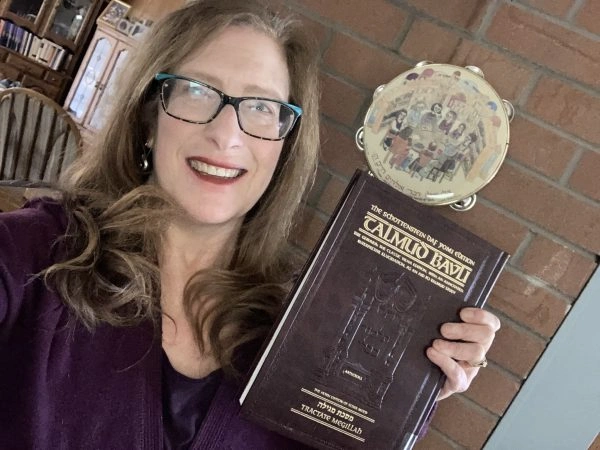Zevachim 8
Share this shiur:
Masechet Zevachim
Masechet Zevachim is sponsored by Esther Kremer in loving memory of her father, Manny Gross on his third yahrzeit. “He exemplified a path of holiness and purity, living with kedushah in his everyday life.”
Want to dedicate learning? Get started here:

Summary
Seder Kodashim Kit – Order Form
If any of the four sacrificial rites of a sin offering – slaughtering, collecting the blood, carrying it, or sprinkling it – are performed with the intent of a different sacrifice or for a different owner, the offering is disqualified. The Gemara investigates the source of this law. Initially, it cites verses that establish the requirement to slaughter, collect, and sprinkle the blood with the correct intent, both for the appropriate sacrifice and for the proper owner, and that failure to do so invalidates the offering. However, these sources do not explicitly prove that intent for a different sacrifice disqualifies the offering, nor that slaughtering and collecting must be done for the correct owner.
The Gemara first attempts to derive this from verses concerning the sin offerings of a nazirite and a leper, but both are rejected due to unique stringencies in each case. It then explores combinations – nazirite and leper, nazirite and standard sin offering, or leper and standard sin offering – but each pairing is also dismissed, as each has its own distinctive stringency.
Ultimately, Rava derives the requirement to perform all rites with the correct intent, from both the perspective of the sacrifice and the owner, from a verse that juxtaposes the peace offering with the sin offering, as the source for the basic law of proper intent is found in the laws of the peace offering, as explained in Zevachim 4. The verses previously cited in the sugya are then reinterpreted to teach that without proper designation, the offering is invalid—based on the principle that in kodashim (sacrificial laws), repetition in the Torah indicates necessity (l’akev).
The proof from the verses above pertains to a standard sin offering. The Gemara then asks: how do we know the same applies to a sin offering brought for idol worship or to a sliding-scale offering (korban oleh veyored)? These cases are derived through comparative analysis with other offerings mentioned previously.
The discussion shifts to the case of a Pesach offering. If one designates an animal for the Passover sacrifice but slaughters it on a day that is not Pesach, the offering is not disqualified and is instead brought as a peace offering. The father of Shmuel cites a verse from Vayikra 3:6, which discusses peace offerings, as the source. However, a difficulty arises: the verse may only support the case where the animal was offered as a peace offering. If it were offered with the intent for a different sacrifice, it might be disqualified.
To address this, the Gemara explains that the term zevach in the verse encompasses other types of offerings. Yet this resolution is unsatisfactory, as it could still be argued that if the Pesach was offered with intent for any other sacrifice, it should be brought as that sacrifice, not necessarily as a peace offering. To resolve this, the Gemara presents two alternative derivations from the verse and proceeds to analyze their validity.
Today’s daily daf tools:
Masechet Zevachim
Masechet Zevachim is sponsored by Esther Kremer in loving memory of her father, Manny Gross on his third yahrzeit. “He exemplified a path of holiness and purity, living with kedushah in his everyday life.”
Today’s daf is sponsored by Elana and Danny Storch in honor of Rhona Fink’s birthday. “Yomuledet sameach and mazal tov. May it be a year filled with continued mazal, b’riut and bracha for many years to come. Shana tova.”
Today’s daily daf tools:
Delve Deeper
Broaden your understanding of the topics on this daf with classes and podcasts from top women Talmud scholars.
New to Talmud?
Check out our resources designed to help you navigate a page of Talmud – and study at the pace, level and style that fits you.
The Hadran Women’s Tapestry
Meet the diverse women learning Gemara at Hadran and hear their stories.
Zevachim 8
״וְלָקַח הַכֹּהֵן מִדַּם הַחַטָּאת״ – שֶׁתְּהֵא קַבָּלָה לְשֵׁם חַטָּאת.
“And the priest shall take of the blood of the sin offering” (Leviticus 4:25), teaching that the collection of the blood must be performed for the sake of a sin offering.
וְאַשְׁכְּחַן שְׁחִיטָה וְקַבָּלָה, זְרִיקָה מְנָלַן? דְּאָמַר קְרָא: ״וְכִפֶּר עָלָיו הַכֹּהֵן מֵחַטָּאתוֹ״ – שֶׁתְּהֵא כַּפָּרָה לְשֵׁם חַטָּאת.
The Gemara asks: And we found a source for the halakha that the slaughter and collection must be performed for the sake of a sin offering. From where do we derive this halakha with regard to the sprinkling of the blood? The Gemara answers: It is derived from a verse, as the verse states: “And the priest shall make atonement for him concerning his sin” (Leviticus 4:26), teaching that the atonement must be effected for the sake of a sin offering, as atonement is effected by the sprinkling of the blood.
אַשְׁכְּחַן שִׁנּוּי קֹדֶשׁ, שִׁנּוּי בְּעָלִים מְנָלַן? אָמַר קְרָא: ״עָלָיו״ – עָלָיו וְלֹא עַל חֲבֵירוֹ.
The Gemara asks: We found a source for the prohibition against deviation from the type of offering. From where do we derive the prohibition against deviation with regard to the owner? The Gemara answers: The aforementioned verse states: “And the priest shall make atonement for him,” indicating that the intent must be for him, and not for another.
אַשְׁכְּחַן לְמִצְוָה, לְעַכֵּב מְנָלַן? כִּדְאָמַר רַב הוּנָא בְּרֵיהּ דְּרַב יְהוֹשֻׁעַ: ״חַטָּאת״–״חַטָּאתוֹ״; הָכָא נָמֵי: ״חַטָּאת״–״חַטָּאתוֹ״.
The Gemara asks: We found a source for the mitzva to sprinkle the blood for the sake of the owner ab initio. From where do we derive that this is indispensable and disqualifies the offering if not fulfilled? The Gemara answers: It is as Rav Huna, son of Rav Yehoshua, says with regard to the sin offering of a nazirite: Since the verse could have simply stated: Sin offering, but instead stated: “His sin offering” (Numbers 6:16), it is inferred that the offering must be sacrificed for his, the owner’s, sake. Here too, since the verse could have simply stated “sin,” but states “his sin,” one infers that if the blood of the sin offering is not sprinkled for the sake of its owner, it is disqualified.
אַשְׁכְּחַן מִצְוָה – בְּשִׁנּוּי קֹדֶשׁ, וּזְרִיקָה בְּשִׁנּוּי בְּעָלִים – בֵּין לְמִצְוָה בֵּין לְעַכֵּב. לְעַכֵּב – בְּכׇל עֲבוֹדוֹת בְּשִׁנּוּי קֹדֶשׁ, וּבִשְׁאָר עֲבוֹדוֹת בְּשִׁנּוּי בְּעָלִים – בֵּין לְמִצְוָה בֵּין לְעַכֵּב, מְנָלַן?
The Gemara asks: We found a source for the mitzva of sacrificing a sin offering without deviation from the type of offering ab initio, and with regard to sprinkling its blood without deviation with regard to the owner concerning both its mitzva ab initio and its indispensability. From where do we derive that performing all sacrificial rites without deviation from the type of offering is an indispensable requirement, and that performing all other rites, besides sprinkling the blood, without deviation with regard to the owner is both a mitzva ab initio and indispensable?
אָמַר רַבִּי יוֹנָה: אָתְיָא מֵחַטַּאת נָזִיר, דִּכְתִיב: ״וְהִקְרִיב הַכֹּהֵן לִפְנֵי ה׳ וְעָשָׂה אֶת חַטָּאתוֹ וְאֶת עֹלָתוֹ״ – שֶׁיְּהוּ כׇּל עֲשִׂיּוֹתָיו לְשֵׁם חַטָּאת.
Rabbi Yona says: It is derived from the halakha concerning the sin offering of a nazirite; as it is written concerning a nazirite: “And the priest shall bring them before the Lord, and shall offer [ve’asa] his sin offering, and his burnt offering” (Numbers 6:16). The verse teaches that all of its sacrificial actions [asiyyotav] must be performed for the sake of a sin offering.
אַשְׁכְּחַן שִׁנּוּי קֹדֶשׁ, שִׁנּוּי בְּעָלִים מְנָלַן? (אִם אֵינוֹ עִנְיָן לְשִׁנּוּי קֹדֶשׁ, תְּנֵיהוּ עִנְיָן לְשִׁנּוּי בְּעָלִים. אַשְׁכְּחַן לְמִצְוָה, לְעַכֵּב מְנָלַן?)
The Gemara asks: We found a source for the halakha that a sin offering must be sacrificed without deviation from the type of offering, and that this requirement is indispensable. From where do we derive that sacrificing it without deviation with regard to the owner is also indispensable, even in rites other than the sprinkling of the blood?
אָמַר רַב הוּנָא בְּרֵיהּ דְּרַב יְהוֹשֻׁעַ: ״חַטָּאת״–״חַטָּאתוֹ״.
Rav Huna, son of Rav Yehoshua, says: Since the verse concerning a nazirite could have simply stated: Sin offering, but instead states: “His sin offering,” one infers that the offering must be sacrificed for the owner’s sake.
מַתְקֵיף לַהּ רָבִינָא: אֶלָּא מֵעַתָּה, ״עוֹלַת״–״עוֹלָתוֹ״ מַאי דָּרְשַׁתְּ בֵּיהּ?
Ravina objects to this: If that is so, what do you interpret from the fact that the same verse could have stated: Burnt offering, but instead states: “His burnt offering”?
וּלְרָבִינָא, ״מִנְחָת״–״מִנְחָתוֹ״, ״נֶסֶךְ״–״נִסְכּוֹ״, מַאי דָּרְשַׁתְּ בְּהוּ?
The Gemara asks: And according to Ravina, what do you interpret from the subsequent verse: “The priest shall offer also his meal offering and his libation” (Numbers 6:17)? Why does Ravina not mention that this verse could have stated: Meal offering, but instead states: “His meal offering,” and that it could have stated: Libation, but instead states: “His libation”?
הָהוּא מִבְּעֵי לֵיהּ: ״מִנְחָתָם וְנִסְכֵּיהֶם״ – בַּלַּיְלָה, ״מִנְחָתָם וְנִסְכֵּיהֶם״ – אֲפִילּוּ לְמָחָר. אֶלָּא ״עוֹלַת״–״עוֹלָתוֹ״, מַאי דָּרְשַׁתְּ בְּהוּ?
The Gemara answers: That language is necessary; it is just like the phrase: “Their meal offering and their libations,” which is mentioned many times in the portion of the Festival offerings (e.g., Numbers 29:37). It teaches that the meal offerings and libations that are brought with the additional animal offerings of the Festivals can be sacrificed even at night after the offering is brought. The phrase: “Their meal offering and their libations,” also teaches that they may be brought even on the following day. Likewise here, when stated with regard to a nazirite, the phrase teaches that they may be brought at night or the day after the offering is sacrificed. But there remains a difficulty: What do you interpret from the fact that the verse could have stated: Burnt offering, but instead states: “His burnt offering”?
וְתוּ, מִי גָּמְרִי מֵהֲדָדֵי?! חַטַּאת חֵלֶב מֵחַטַּאת נָזִיר לָא גָּמְרָה – שֶׁכֵּן יֵשׁ עִמָּהּ דָּמִים אֲחֵרִים; חַטַּאת נָזִיר מֵחַטַּאת חֵלֶב לָא גָּמְרָה – שֶׁכֵּן כָּרֵת!
The Gemara raises an additional objection to the derivation from a nazirite’s sin offering: And furthermore, can the halakhot of a standard sin offering and of a nazirite’s sin offering be derived from one another? The halakhot of a sin offering brought for a transgression, e.g., eating forbidden fat, cannot be derived from the halakhot of a nazirite’s sin offering, due to the unique element of stringency of the latter, since there is other blood, i.e., other offerings are brought, with it. Likewise, the halakhot of a nazirite’s sin offering cannot be derived from the halakhot of a sin offering brought for eating forbidden fat, due to the unique element of stringency of the latter, since it atones for a transgression punishable by excision from the World-to-Come [karet].
אֶלָּא אָמַר רָבָא: אָתְיָא מֵחַטַּאת מְצוֹרָע, דִּכְתִיב: ״וְעָשָׂה הַכֹּהֵן אֶת הַחַטָּאת״ – שֶׁיְּהוּ כׇּל עֲשִׂיּוֹתָיו לְשֵׁם חַטָּאת.
Rather, Rava says: These halakhot are derived from the halakha of the sin offering of a leper; as it is written: “And the priest shall offer [ve’asa] the sin offering” (Leviticus 14:19), teaching that all sacrificial actions of [asiyyotav] a sin offering must be performed for the sake of a sin offering.
וְאַשְׁכְּחַן שִׁנּוּי קֹדֶשׁ, שִׁנּוּי בְּעָלִים מְנָלֵיהּ? אָמַר קְרָא: ״וְכִפֶּר עַל הַמִּטַּהֵר וְגוֹ׳״ – עַל הַמִּטַּהֵר זֶה, וְלֹא עַל הַמִּטַּהֵר חֲבֵירוֹ.
And we found a source for the halakha that a sin offering must be sacrificed without deviation from the type of offering, and that this is indispensable. From where do we derive that sacrificing a sin offering without deviation with regard to the owner is also indispensable? The verse states: “And make atonement for the one that is to be purified of his impurity” (Leviticus 14:19), indicating that the sin offering must be sacrificed for the sake of this person who is being purified, and not for another person who is to be purified.
וְאַכַּתִּי, מִי יָלְפָא מֵהֲדָדֵי?! חַטַּאת חֵלֶב מֵחַטַּאת מְצוֹרָע לָא יָלְפָא – שֶׁכֵּן יֵשׁ עִמָּהּ דָּמִים אֲחֵרִים; חַטָּאת מְצוֹרָע מֵחַטַּאת חֵלֶב לָא גָּמְרָה – שֶׁכֵּן כָּרֵת!
The Gemara asks: But still, can the halakhot of a standard sin offering and a leper’s sin offering be derived from one another? This comparison is also problematic. The halakhot of a sin offering brought for eating forbidden fat cannot be derived from the halakhot of a leper’s sin offering, since there is other blood that is brought with the latter, i.e., a burnt offering and a guilt offering; and the halakhot of a leper’s sin offering cannot be derived from the halakhot of a sin offering brought for eating forbidden fat, since the latter atones for a transgression punishable by karet.
מֵחֲדָא לָא אָתְיָא, תֵּיתֵי חֲדָא מִתַּרְתֵּי.
The Gemara answers: Indeed, the halakhot of a sin offering cannot be derived from the halakhot of one other type of sin offering alone. But one can derive the halakhot of one type of sin offering from the halakhot of the other two. The verses concerning a standard sin offering, that of a leper, and that of a nazirite all contain elements that indicate that the offering must be sacrificed for its own sake. Two of them together are sufficient to teach that this halakha applies to the third case. The third case is therefore apparently extraneous, and it is understood to teach that proper intent in this regard is indispensable for all the offering’s rites.
בְּהֵי לָא לִכְתּוֹב? [לָא לִכְתּוֹב] רַחֲמָנָא בְּחַטַּאת חֵלֶב, וְתֵיתֵי מֵהָנָךְ?! מָה לְהָנָךְ, שֶׁכֵּן יֵשׁ עִמָּהֶם דָּמִים אֲחֵרִים!
The Gemara asks: With regard to which type of sin offering should the Torah not have written this halakha, i.e., which of the three cases should be regarded as the extraneous case? If you say: Let the Merciful One not write it with regard to a sin offering brought for eating forbidden fat, and one can derive it from these other sin offerings, i.e., those of a nazirite and a leper, this can be refuted: What is notable about these other sin offerings? They are notable in that there is other blood brought with them. Therefore, the halakha should apply only to similar sin offerings.
לָא לִכְתּוֹב רַחֲמָנָא בְּחַטַּאת נָזִיר, וְתֵיתֵי מֵהָנָךְ?! מָה לְהָנָךְ, שֶׁכֵּן אֵין לָהֶן שְׁאֵלָה!
If you say: Let the Merciful One not write it with regard to a nazirite’s sin offering, and one can derive it from these other sin offerings, those of a leper and a sinner, this can also be refuted: What is notable about these other sin offerings? They are notable in that one does not have the option of obtaining an exemption through a request to a halakhic authority. A nazirite, by contrast, can request of a halakhic authority to dissolve his vow of naziriteship, thereby nullifying his obligation.
לָא לִכְתּוֹב רַחֲמָנָא בְּחַטַּאת מְצוֹרָע, וְתֵיתֵי מֵהָנָךְ?! מָה לְהָנָךְ, שֶׁכֵּן אֵין בָּאִין בְּדַלּוּת!
If you say: Let the Merciful One not write it with regard to a leper’s sin offering, and one can derive it from these other sin offerings, those of a nazirite and a sinner, this can also be refuted: What is notable about these other sin offerings? They are notable in that they cannot be brought from doves instead of sheep if the owner is poor, unlike a leper’s sin offering (see Leviticus 14:21). Therefore, the halakhot of these different sin offerings cannot be derived from one another.
אֶלָּא אָמַר קְרָא: ״זֹאת הַתּוֹרָה לָעֹלָה וְלַמִּנְחָה וְגוֹ׳״ – הִקִּישׁוֹ הַכָּתוּב לִשְׁלָמִים; מָה שְׁלָמִים – בֵּין שִׁנּוּי קֹדֶשׁ בֵּין שִׁנּוּי בְּעָלִים, בָּעֵינַן לִשְׁמָן לְמִצְוָה; אַף חַטָּאת – בֵּין שִׁנּוּי קֹדֶשׁ בֵּין שִׁנּוּי בְּעָלִים, בָּעֵינַן לִשְׁמָן לְמִצְוָה.
Rather, the halakha is derived from that which the verse states: “This is the law of the burnt offering, and of the meal offering, and of the sin offering, and of the guilt offering, and of the consecration offering, and of the sacrifice of peace offerings” (Leviticus 7:37). The verse juxtaposes a sin offering with a peace offering, indicating that just as for a peace offering we require intent for its sake, as a mitzva ab initio, both concerning the deviation from the type of offering and concerning deviation with regard to the owner, so too, for a sin offering we require intent for its sake as a mitzva, both concerning deviation from the type of offering and concerning deviation with regard to the owner.
הִילְכָּךְ, מִצְוָה – מִשְּׁלָמִים, וְהָנָךְ קְרָאֵי – לְעַכֵּב.
Therefore, the mitzva ab initio is derived from the halakha of a peace offering; and those verses mentioned earlier, from which this requirement is derived with regard to each type of sin offering separately, repeat the halakha to teach that it is indispensable.
וְאַשְׁכְּחַן חַטַּאת חֵלֶב, דִּכְתִיב בָּהּ ״לַחַטָּאת״;
The Gemara asks: And we found a source for these halakhot with regard to a sin offering brought for eating forbidden fat, as it is written with regard to it: “And slaughter it for a sin offering” (Leviticus 4:33), indicating that it must be slaughtered for the sake of a sin offering. Likewise, sources for this halakha with regard to the sin offerings of a nazirite and a leper have also been cited.
חַטָּאת דַּעֲבוֹדָה זָרָה, דִּשְׁמִיעַת הַקּוֹל, וּבִטּוּי שְׂפָתַיִם, וְטוּמְאַת מִקְדָּשׁ וְקָדָשָׁיו – דְּלָא כְּתִיב בְּהוּ; מְנָלַן?
From where do we derive these halakhot with regard to a sin offering brought for idol worship, which has unique halakhot, as detailed in Numbers 15:27–31, and with regard to which the term: For a sin offering, is not written? Likewise, from where do we derive them with regard to the sin offerings that are brought for the hearing of the voice, and for an utterance of the lips, and for the defiling of the Temple or its sacrificial foods, which also have unique halakhot (Leviticus 5:1–13), and with regard to which the term: For a sin offering, is not written either?
חַטָּאת דַּעֲבוֹדָה זָרָה – אָתְיָא מֵחַטַּאת חֵלֶב, שֶׁכֵּן כָּרֵת כְּמוֹתָהּ; וְהָנָךְ כּוּלְּהִי – אָתְיָין בְּמָה הַצַּד.
The Gemara answers: With regard to a sin offering brought for idol worship, these halakhot are derived from the halakhot of a sin offering brought for eating forbidden fat, as idol worship is also punishable by karet, similar to consumption of forbidden fat. And with regard to all these other sin offerings, which are brought for transgressions not punishable by karet, these halakhot are derived by analogy from the common element of the aforementioned three sources, namely, a standard sin offering, the sin offering of a nazirite, and the sin offering of a leper.
תָּנוּ רַבָּנַן: פֶּסַח בִּזְמַנּוֹ – לִשְׁמוֹ כָּשֵׁר, שֶׁלֹּא לִשְׁמוֹ פָּסוּל; וּבִשְׁאָר יְמוֹת הַשָּׁנָה – לִשְׁמוֹ פָּסוּל, שֶׁלֹּא לִשְׁמוֹ כָּשֵׁר.
§ The Sages taught: When a Paschal offering is sacrificed at its appointed time, on Passover eve after noon, if it is sacrificed for its sake, it is fit; if it is sacrificed not for its sake, it is unfit, as stated in the mishna. And when an offering consecrated as a Paschal offering is sacrificed during the rest of the days of the year, if it is sacrificed for its sake, it is unfit; if it is sacrificed not for its sake, it is fit.
(של״ו קבאיצ״ן ממה״ר בצ״א ב״א סִימָן)
The Gemara presents a mnemonic for the names of the amora’im mentioned in this discussion: Shin, lamed, vav; kuf, beit, alef, yod, tzadi, nun; mem, mem, heh, reish; beit, tzadi, alef; beit, alef.
מְנָא הָנֵי מִילֵּי? אָמַר אֲבוּהּ דִּשְׁמוּאֵל, אָמַר קְרָא: ״וְאִם מִן הַצֹּאן קׇרְבָּנוֹ לְזֶבַח שְׁלָמִים לַה׳״ – דָּבָר הַבָּא מִן הַצֹּאן יְהֵא לְזֶבַח שְׁלָמִים.
The Gemara asks: From where are these matters derived, i.e., that if a Paschal offering is sacrificed during the rest of the year it is fit if sacrificed not for its sake? Shmuel’s father says: The verse states: “And if his offering for a sacrifice of peace offerings unto the Lord is of the flock” (Leviticus 3:6), indicating that an offering that is brought only from the flock will be a sacrifice of peace offerings. The Paschal offering fulfills this criterion.
אֵימָא שְׁלָמִים אִין, מִידֵּי אַחֲרִינָא לָא! אָמַר רַבִּי אִילָא אָמַר רַבִּי יוֹחָנָן: ״לְזֶבַח״ – לְרַבּוֹת כׇּל זֶבַח.
The Gemara challenges: Say that if it is sacrificed for the sake of a peace offering, yes, it is fit, but if it is sacrificed for the sake of some other offering, it is not fit. Rabbi Ila says that Rabbi Yoḥanan says: The redundant expression “for a sacrifice” in Leviticus 3:6 is stated to include any type of sacrifice.
אֵימָא כֹּל דְּשָׁחֵיט – לֶהֱוֵי כְּמוֹתָהּ!
The Gemara asks: If so, say that a Paschal offering should be rendered as any offering for which one slaughters it; for example, if it is slaughtered for the sake of a burnt offering, it should be rendered a burnt offering.
אִי הֲוָה כְּתִיב ״לִשְׁלָמִים וְזֶבַח״ – כִּדְקָאָמְרַתְּ; הַשְׁתָּא דִּכְתִיב ״לְזֶבַח שְׁלָמִים״ – לְכֹל דְּשָׁחֵיט לֵיהּ, שְׁלָמִים לֶהֱוֵי.
The Gemara answers: If the phrase: For peace offerings and a sacrifice, was written in the verse, it would be as you say. Now that it is written: “For a sacrifice of peace offerings,” it indicates that for whatever type of offering one slaughters it, it will be a peace offering.
אֵימָא: ״לְזֶבַח״ – כָּלַל, ״שְׁלָמִים״ – פָּרַט; כְּלָל וּפְרָט – אֵין בַּכְּלָל אֶלָּא מַה שֶׁבַּפְּרָט; שְׁלָמִים אִין, מִידֵּי אַחֲרִינָא לָא!
The Gemara challenges: Say that: “For a sacrifice,” is a generalization and: “Of peace offerings,” is a detail, and according to the principles of biblical hermeneutics, wherever there is a generalization and a detail, the generalization includes only that which is specified in the detail. Accordingly, if the offering is sacrificed for the sake of a peace offering, yes, it is fit; but if it is sacrificed for the sake of another offering, it is not fit.
״לַה׳״ – הָדַר וְכָלַל.
The Gemara answers: With the term: “Unto the Lord,” the verse then generalized again. Therefore, the verse is formulated as a generalization, a detail, and a generalization, as the Gemara will explain.
מַתְקֵיף לַהּ רַב יַעֲקֹב מִנְּהַר פְּקוֹד: הָא לָא דָּמֵי כְּלָלָא בָּתְרָא לִכְלָלָא קַמָּא; כְּלָלָא קַמָּא – מְרַבֵּי זְבָחִים וְתוּ לָא; כְּלָלָא בָּתְרָא – ״לַה׳״ כֹּל דְּלַה׳, וַאֲפִילּוּ לְעוֹפוֹת וַאֲפִילּוּ לִמְנָחוֹת!
Rav Ya’akov of Nehar Pekod objects to this suggestion: But the latter generalization is dissimilar to the former generalization. The former generalization: “For a sacrifice,” includes only slaughtered offerings and nothing more, whereas the latter generalization: “Unto the Lord,” includes any offering unto the Lord. And accordingly, even if the Paschal offering was sacrificed for the sake of bird offerings, or even for the sake of meal offerings, it should be fit, as these are brought “unto the Lord.”
הָא תַּנָּא דְּבֵי רַבִּי יִשְׁמָעֵאל, בִּכְלָלֵי וּפְרָטֵי דָּרֵישׁ כִּי הַאי גַוְונָא:
The Gemara responds to this objection: The school of Rabbi Yishmael taught generalizations and details even in examples like this case.
כְּלָל וּפְרָט וּכְלָל – אִי אַתָּה דָן אֶלָּא כְּעֵין הַפְּרָט; מָה הַפְּרָט מְפוֹרָשׁ – שֶׁהוּא שֶׁלֹּא לִשְׁמוֹ, וְכָשֵׁר; אַף כֹּל – שֶׁהוּא שֶׁלֹּא לִשְׁמוֹ, וְכָשֵׁר.
The Gemara explains: Since “unto the Lord” is a second generalization, the verse is formulated as a generalization, and a detail, and a generalization, and you may deduce that the verse is referring only to items similar to the detail. Just as the items mentioned in the detail are clearly defined as a case where a Paschal offering was sacrificed not for its own sake, and nevertheless it is fit, so too, in any case where it was sacrificed not for its sake but for the sake of another offering, it is fit.
אִי – מָה הַפְּרָט מְפוֹרָשׁ, דָּבָר הַבָּא בְּנֶדֶר וּבִנְדָבָה; אַף כׇּל הַבָּא בְּנֶדֶר וּבִנְדָבָה – עוֹלָה וּשְׁלָמִים אִין, חַטָּאת וְאָשָׁם לֹא!
The Gemara asks: If the verse is referring only to actions similar to the detail, then just as the items mentioned in the detail are clearly defined as a peace offering, which is a matter that is brought as a vow offering or as a gift offering, so too, a Paschal offering should be fit only if it was sacrificed for the sake of any offering that is brought as a vow offering or as a gift offering. Accordingly, if it was sacrificed for the sake of a burnt offering or a peace offering, yes, it is fit, as these are brought as a vow offering or as a gift offering; but if it was sacrificed for the sake of a sin offering or a guilt offering, it is not fit, as these are not brought as a vow offering or as a gift offering.
אֶלָּא ״לְזֶבַח״ – רִבּוּיָא הוּא.
The Gemara therefore rejects the exegetical method of generalizations and details in favor of that of amplifications and restrictions: Rather, the term: “For a sacrifice,” is not a generalization, but an amplification, which includes any type of offering. Therefore, if a Paschal offering is sacrificed for the sake of any type of offering during the rest of the year, it is fit.
אֵימָא לְכֹל דְּשָׁחֵיט לֵיהּ – לֶהֱוֵי כְּוָותֵיהּ!
The Gemara challenges: If so, say that it adds that a Paschal offering should be rendered as any offering for which one slaughters it. Why does Shmuel’s father interpret that it is rendered a peace offering specifically?
אָמַר רַבִּי אָבִין:
Rabbi Avin says:






















